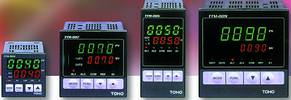

Users and suppliers have much to be grateful for when it comes to the microprocessor that is built into modern temperature and process controllers. It gives us all a ready source of highly accurate and reliable controllers - and all this at a cost that will not break the bank.
Going back only a decade or two the instrument landscape was very different. The writer remembers huge grey or black monstrosities that were attached to unwieldy steel wires (capillaries) that ended in metal tubes sometimes bigger than a Cuban cigar. These mechanical systems worked on the expansion of fluids. The controllers and recorders were filled with highly dangerous and noxious materials such as mercury, xylene, or Arcton 12, any of which would be banned out-of-hand by modern standards. One break in the capillary of this type of instrument resulted in costly downtime or complete replacement.
The electronic equivalent of the filled system instrument at that time was equally fraught with setbacks and pitfalls. Moving coil meters driven directly from thermocouples were fragile, temperamental and hard to transport. The switching or control electronics normally consisted of a light source with a flag precariously balanced on the end of the wobbling pointer. This flag was moved to obscure the light to a receiver and thus in turn switched a relay.
As an apprentice in England many hours were spent winding nickel wire balance bobbins for these instruments.
The next generation of instruments normally referred to as 'potentiometric' used an amplified signal to position pointers and pen arms, etc. There were many different types of the amplified movements ranging from servomotors to linear motors which balanced a coil between two permanent magnets. These were much more sophisticated and allowed the introduction of PID control, albeit with very limited proportional bands.
These potentiometric instruments had, apart from others, one major advantage. The agent now had the capability of being able to change ranges and scales locally. With a box of ranging resistors and a selection of scales, an agent anywhere in the world could give a customer more or less what he needed in respect of inputs and ranges. Still not a microprocessor in sight.
Do you remember the old 'cam' controllers that were used to increase and decrease the temperature of kilns and furnaces, etc? These nightmares used a cut perspex cam attached to the drive spindle of a circular chart recorder. The custom made cam had an arm that rolled along the outside edge and switched a tiny set of contacts on and off. The writer shivers when he thinks of the problems of trying to align the contacts and cutting cams. Nowadays we have microprocessor-based ramping controllers that hold multiple programs in their memories. Fuzzy logic, event outputs alarms and computer communications are passé.
Then came the 'new age' controller with selectable inputs at the touch of a button, PID/ON-OFF control, digital scaling for transducers, alarms, reverse or direct acting selection, digital inputs for remote settings, retransmission and PLC interface, and on and on...
Thinking about those non-microprocessor-based pioneering systems now, in the light of the modern controller, makes the writer's blood run cold. The adage 'Those were the days', will never pass these lips.
With the advent of the microprocessor we, as suppliers, can deliver a sophisticated controller to a customer in a matter of hours. They are smaller and getting even smaller and more powerful. The cost against value for money is almost ridiculous compared to what was offered in the past.
The picture shows some of the types of controllers offered by Temp-Tek. These are programmable units with selectable inputs and multiple outputs. There are various sizes and options available.
Temp-Tek also stocks ramping controllers that can follow a temperature pattern, multipoint recorders that can have a different input on each pen and that print time, date, value, etc, on the chart.
As a supplier of instruments Temp-Tek also holds in stock simple non-microprocessor-based on/off controllers to suit 'low tech' applications such as plastic injection machines and low temperature ovens. Other items are solid-state relays, small thyristors, humidity sensors and pressure transmitters.
Temp-Tek's policy is to keep company overheads and costs to a minimum and thus offer customers a low-cost, efficient, immediate and often personal service. Large stocks of instruments are held in readiness for despatch within a few hours if necessary.
For more information contact Roy Embling, Temp-Tek, 011 465 8066, [email protected]
| Tel: | +27 11 465 8066 |
| Email: | [email protected] |
| www: | www.temptek.co.za |
| Articles: | More information and articles about Temp-Tek |

© Technews Publishing (Pty) Ltd | All Rights Reserved